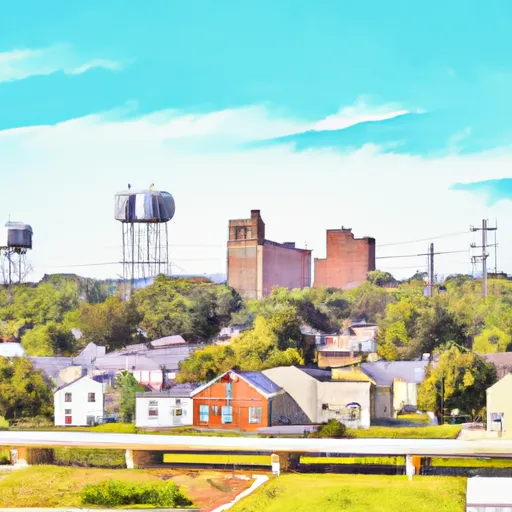-
 Snoflo Premium
Snoflo Premium
Get unlimited access to all our content
With no Ad interruptions! - Start Your Free Trial Login with existing account
Kinsman
Eden Index
Climate
7.8
•
Recreation
3.8
•
Community
•
Safeguard
4.5/10

Kinsman, Illinois is a small village located in Grundy County. The climate in Kinsman is characterized by warm summers and cold winters. Average temperatures range from the mid-80s°F (30°C) in summer to the mid-20s°F (-4°C) in winter. Rainfall is evenly distributed throughout the year, with approximately 40 inches (1,016 mm) annually.
The village is home to some beautiful hydrological features, including the scenic Mazon River that flows through the area. The river provides an opportunity for fishing enthusiasts to enjoy angling for various species, such as bass, catfish, and sunfish.
Outdoor recreation opportunities in Kinsman abound. The nearby Mazonia-Braidwood State Fish and Wildlife Area offers excellent hunting, fishing, and wildlife viewing experiences. The 2,640-acre park is also equipped with picnic areas and hiking trails, making it a perfect spot for nature lovers.
Overall, Kinsman, Illinois offers a pleasant climate, picturesque hydrology features, and diverse outdoor recreation opportunities, making it an attractive destination for those seeking to explore nature and indulge in outdoor activities.
What is the Eden Index?
The Snoflo Eden Index serves as a comprehensive rating system for regions, evaluating their desirability through a holistic assessment of climate health, outdoor recreation opportunities, and natural disaster risk, acknowledging the profound impact of these factors on livability and well-being.
Climate Health Indicator (CHI): 7.8
Kinsman receives approximately
936mm of rain per year,
with humidity levels near 82%
and air temperatures averaging around
10°C.
Kinsman has a plant hardyness factor of
5, meaning
plants and agriculture in this region thrive during a short period during spring and early summer. Most
plants will die off during the colder winter months.
By considering the ideal temperature range, reliable water supplies, clean air, and stable seasonal rain or snowpacks, the Climate Health Indicator (CHI) underscores the significance of a healthy climate as the foundation for quality living.
A healthy climate is paramount for ensuring a high quality of life and livability in a region, fostering both physical well-being and environmental harmony. This can be characterized by ideal temperatures, reliable access to water supplies, clean air, and consistent seasonal rain or snowpacks.
Weather Forecast
Streamflow Conditions
Upper Illinois
Area Rivers
Upper Illinois
Snowpack Depths
Upper Illinois
Reservoir Storage Capacity
Upper Illinois
Groundwater Levels
Recreational Opportunity Index (ROI): 3.8
The Recreational Opportunity Index (ROI) recognizes the value of outdoor recreational options, such as parks, hiking trails, camping sites, and fishing spots, while acknowledging that climate plays a pivotal role in ensuring the comfort and consistency of these experiences.
Access to outdoor recreational opportunities, encompassing activities such as parks, hiking, camping, and fishing, is crucial for overall well-being, and the climate plays a pivotal role in enabling and enhancing these experiences, ensuring that individuals can engage in nature-based activities comfortably and consistently.
Camping Areas
| Campground | Campsites | Reservations | Toilets | Showers | Elevation |
|---|---|---|---|---|---|
| Livingston County 4-H Park | None | 636 ft | |||
| Sam Dale Lake Conservation Area | None | 493 ft | |||
| Jurgens City Park | None | 658 ft | |||
| Stephen A. Forbes State Park | 135 | 604 ft | |||
| Coon Creek - Shelbyville Lake | 230 | 666 ft | |||
| South City (Gibson) Park | None | 741 ft | |||
| Opossum Creek - Shelbyville Lake | 80 | 654 ft | |||
| Charley Brown City Park | None | 487 ft | |||
| Moraine View State Park | 200 | 853 ft | |||
| Gibson City Park | 4 | 731 ft |
Nearby Ski Areas
Catastrophe Safeguard Index (CSI):
The Catastrophe Safeguard Index (CSI) recognizes that natural disaster risk, encompassing floods, fires, hurricanes, and tornadoes, can drastically affect safety and the overall appeal of an area.
The level of natural disaster risk in a region significantly affects safety and the overall livability, with climate change amplifying these risks by potentially increasing the frequency and intensity of events like floods, fires, hurricanes, and tornadoes, thereby posing substantial challenges to community resilience and well-being.
Community Resilience Indicator (CRI):
The Community Resilience Indicator (CRI) recognizes that education, healthcare, and socioeconomics are crucial to the well-being of a region. The CRI acknowledges the profound impact of these elements on residents' overall quality of life. By evaluating educational resources, healthcare accessibility, and economic inclusivity, the index captures the essential aspects that contribute to a thriving community, fostering resident satisfaction, equity, and social cohesion.

